Saturday, 14 October 2006
written 10/21/06
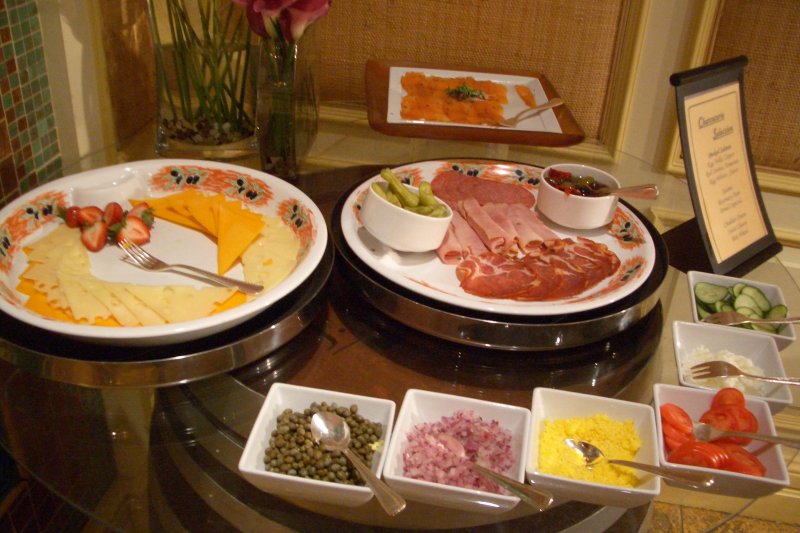
Saturday morning we took advantage of our free run at the
hotel's wonderful buffet breakfast.
It's actually much easier to exercise restraint in the face of so many
delicious choices when you don't feel you have to get your $22's worth. I had (restrained portions of) vegetable
frittata; sharp cheddar; house-smoked salmon with cream cheese, onions, and
capers; tasso-laced grits; bacon; and the outstanding house-made pecan sticky
buns I look forward to every year. The
hotel's own Ritz-Carlton–label bottled water was provided courtesy of the
housekeeping department, which left each of us a small bottle along with our
pillow chocolates the night before. You
can buy it in the coffee shop, and the parking people give it away to guests
departing by car on hot days. I don't
know why the hotel doesn't just have some of it put up in presentable glass
bottles to pour during dinner instead of that awful Italian stuff.
We had an early-afternoon tee time at Laurel Island Links,
in southern Georgia. We'd never been
there before so we left in plenty of time and located it without
difficulty. We had some time to kill
before our tee time, so we set off, back south a little ways, to see
"Historic St. Marys," which we'd seen advertised on our way
north. We followed, for quite a distance
through subdivision after strip mall, the series of little official state of
Georgia signs indicating the direction to Historic St. Marys. Finally, we came to a sign saying
"Welcome to Historic St. Marys!" right in front of another strip
mall. So we kept on driving (all the
while paralleling what the map called "King's Bay Naval Submarine
Base" off to our left somewhere), past strip malls so new their parking
lots hadn't been landscaped yet, past subdivisions still under construction,
for a good 15 more miles, craning our necks for a sight of something vaguely
historic—well, yeah, the cinderblock building on that used-car lot looks like
it might have been there more than five years, and those railroad tracks we
crossed seemed pretty old, and there's an antique shop over there. We were beginning to wonder whether
"Historic" was used in the sense of "formerly called . . ."
when we suddenly found ourselves face to face with a huge old dark-red brick
building, several stories high, with a tall, old-fashioned brick smokestack (apparently idle),
completely unlike any structure for miles around. It reminded us of nothing so much as the
cavernous disused textile factories of Lowell, Massachusetts. The road took one more bend, and abruptly we were
among venerable live oaks and old Victorian clapboard houses.
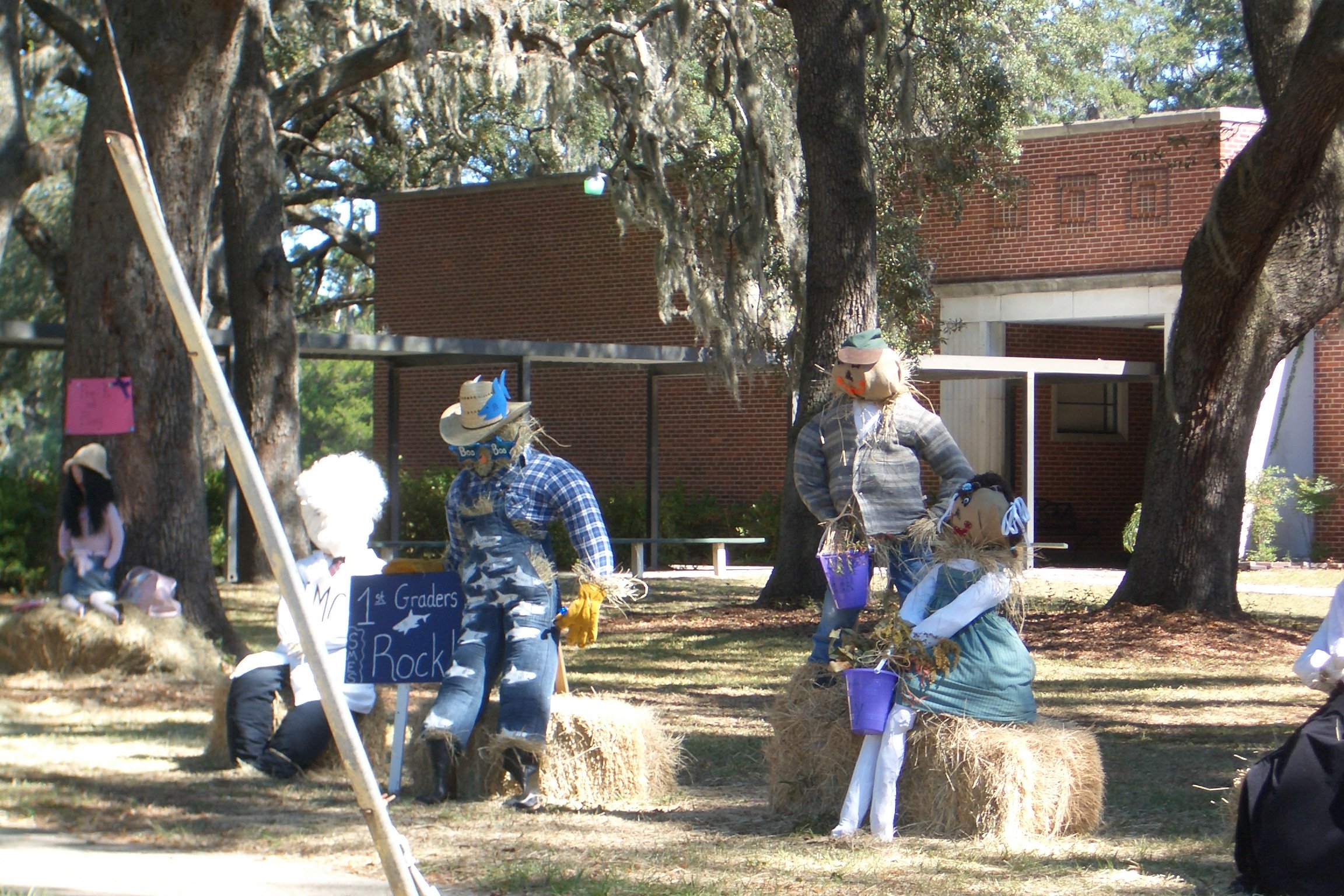
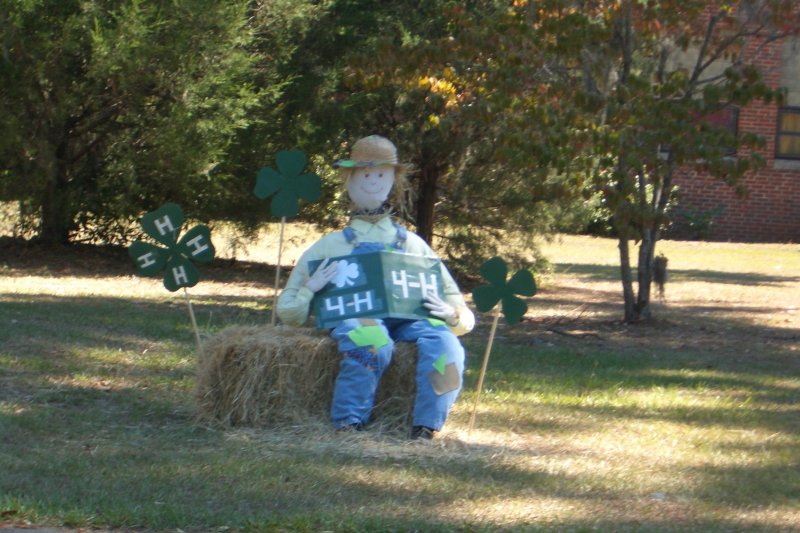 We were slowed at the edge of town by a flagman in a hard
hat and yellow vest holding a "caution" sign, before we noticed that
he was, in fact, a scarecrow, as was the similarly clad guy on a ladder,
stringing fairy lights in the live oak behind him. We had happened on the first weekend of the
(presumably annual) three-weekend St. Marys Scarecrow Extravaganza (leading up
to Halloween), and the town was full of 'em, standing in yards, by the
roadside, on bus-stop benches, in front of stores. We cruised slowly for about six blocks,
admiring the scarecrows and the crowd of kids on the school lawn making more,
until we came to the St. Marys River (actually the junction of river's estuary
and the the inland waterway between the barrier islands and the mainland). There we turned right and cruised another
four blocks, past a lovely river-side park and an assortment of
promising-looking restaurants. That
seemed to be it—bustling downtown Historic St. Marys. It turned out to be home to, among other
things, the headquarters of the Cumberland Island National Seashore, several
antique and gift shops, a submarine museum, and a stand renting glorified golf
carts, just like on Key West. We chose
the Riverside Café for lunch. It turned
out to be (judging by the menu and our server's accent) owned and run by Greeks
but with at least one Asian working in the kitchen. I had an excellent fried grouper sandwich
with coleslaw, tartare sauce, lettuce, tomato, raw onion, and fries, and David
had stirfried shrimp and vegetables in a tasty ginger-sesame-soy sauce served
over pita with a Greek salad on the side.
The town clearly merits a day-long visit (if only to find out what that enormous brick building was about; part of the submarine base?), but our tee time was coming
up, so we set out to find our way back to the golf course—not obviously easy,
since the many signs had led us by a complex and winding route over a number of
back roads, all of which seemed to be "rte. 40" whichever way you
turned. Fortunately, a sign just at the
edge of town pointed the way to the interstate (via rte. 40, of course) and
thereby put us back on the route we knew.
We were slowed at the edge of town by a flagman in a hard
hat and yellow vest holding a "caution" sign, before we noticed that
he was, in fact, a scarecrow, as was the similarly clad guy on a ladder,
stringing fairy lights in the live oak behind him. We had happened on the first weekend of the
(presumably annual) three-weekend St. Marys Scarecrow Extravaganza (leading up
to Halloween), and the town was full of 'em, standing in yards, by the
roadside, on bus-stop benches, in front of stores. We cruised slowly for about six blocks,
admiring the scarecrows and the crowd of kids on the school lawn making more,
until we came to the St. Marys River (actually the junction of river's estuary
and the the inland waterway between the barrier islands and the mainland). There we turned right and cruised another
four blocks, past a lovely river-side park and an assortment of
promising-looking restaurants. That
seemed to be it—bustling downtown Historic St. Marys. It turned out to be home to, among other
things, the headquarters of the Cumberland Island National Seashore, several
antique and gift shops, a submarine museum, and a stand renting glorified golf
carts, just like on Key West. We chose
the Riverside Café for lunch. It turned
out to be (judging by the menu and our server's accent) owned and run by Greeks
but with at least one Asian working in the kitchen. I had an excellent fried grouper sandwich
with coleslaw, tartare sauce, lettuce, tomato, raw onion, and fries, and David
had stirfried shrimp and vegetables in a tasty ginger-sesame-soy sauce served
over pita with a Greek salad on the side.
The town clearly merits a day-long visit (if only to find out what that enormous brick building was about; part of the submarine base?), but our tee time was coming
up, so we set out to find our way back to the golf course—not obviously easy,
since the many signs had led us by a complex and winding route over a number of
back roads, all of which seemed to be "rte. 40" whichever way you
turned. Fortunately, a sign just at the
edge of town pointed the way to the interstate (via rte. 40, of course) and
thereby put us back on the route we knew.
Back at Laurel Island Links, the parking lot, which had been
full of cars but otherwise deserted, was suddenly teeming with returning
golfers, as the tournament that had occupied the course all morning was just
ending. We presented ourselves for our 2
p.m. start and pretty much had the place to ourselves. There were a few other people on the course,
but well ahead of and behind us. It
turned out to be a very pleasant course, well kept and scenic (none of those
vast, gravelly bunkers full of bunch grass that I disliked so much at North
Hampton last year). We encountered a
flock of vultures on the 15th hole, a small raccoon on the 13th (who continued
digging for something, worms maybe, and ignored us serenely as we played
through), and a middle-aged couple who had arrived on bicycles to fish in the
water hazard on the 17th. And it was way cheaper than either the course at
Amelia Island or North Hampton. It's
most amazing feature, though, was its greens.
We thought the greens at Seminole were fast, and they are faster than
Amelia Island, North Hampton, or any other course we've played in Tallahassee,
but at Laurel Island, it was like putting on a hardwood floor! You'd give your ball a gentle tap, and it
would glide on for yards and yards like a dry-ice puck! If your putt was even slightly downslope, you
had to hit the hole, because if you didn't, the ball invariably just kept on
going until it ran off the far side of the green. It was a dryish day, and they must have
rolled those greens just before the tournament and again just after, and I
still can't believe healthy, green, living grass could lie that flat!
Because we played as a twosome and weren't held up by any
parties in front of us, we finished our round in well under four hours, so we
had plenty of time to get back to Amelia Island to the hotel and to clean up
and change for our second dinner at Salt.
We were greeted with effusion by the maître d'hotel, Julie
Bundy (who, both this year and last, could not look less like the classic tuxedoed maître d'—picture
Kathy Bates in a flowered dress and sensible shoes—but who is the kindest of
ladies and runs a great dining room).
Once again, I felt awfully finicky, commenting that the table was so
dark that we wouldn't be able to photograph the food or the menu, but we were
instantly moved to a brighter table, and the waitress brought out the special
non-oily-tasting water. Everyone was so
very solicitous that I worry sometimes that we're dining under false pretenses—because
we take notes and pictures and discuss each course, maybe they think we're
actual food writers or restaurant critics!
As we left the restaurant on Friday night, Ms. Bundy had assured
us that, if we wanted to order the tasting menu again on Saturday, the chef
could do a whole new combination of dishes.
We don't ordinarily do that. We
order the sampler on the first night, then the second night, we either pick out
the winners to order full portions of or use the second meal to try the couple
of interesting items on the menu that didn't show up the night before. This time, though, all the courses had been
so good, and we were intrigued to see whether he had even more winners to trot
out, so we said what the heck: we told
the waitress that we'd like to repeat the bean soup, and that David would like
to repeat the crab, which I couldn't eat because of the avocado in it, but
otherwise, surprise us! So could he do
it again? You betcha!
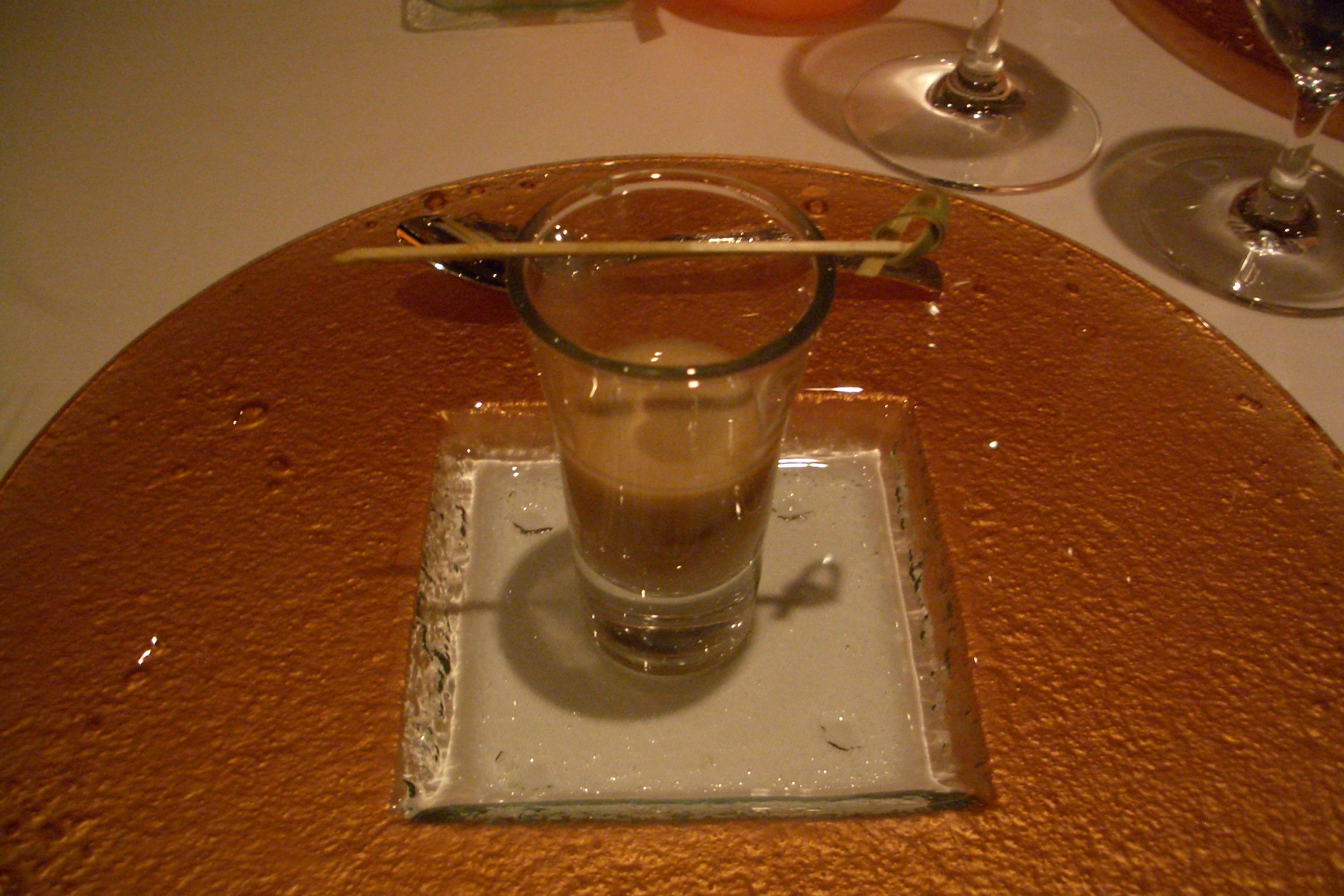 Amuse-bouche: a small
glass of warm chanterelle mushroom soup across which was balanced a tiny bamboo
skewer bearing a warm cube of meltingly tender tea-smoked salmon garnished with a basil
sprout. Aha! This chef has clearly been to Eugénie les
Bains, where we went last summer, and ate at Michel Guerard's top restaurant, which is world famous and has three Michelin stars. The dish was a clear homage to the
amuse-bouche we had there: a tiny teacup
of warm mushroom soup bearing an identical little bamboo skewer (cleverly
knotted to resemble a miniature sword).
Of couse, in Eugénie, the skewer held morsels of grilled sweetbread,
liver, and kidney, which chef Vallès was probably wise not to try on American
diners. Sorry, but I'm afraid I ate the
salmon before we took the photo.
Amuse-bouche: a small
glass of warm chanterelle mushroom soup across which was balanced a tiny bamboo
skewer bearing a warm cube of meltingly tender tea-smoked salmon garnished with a basil
sprout. Aha! This chef has clearly been to Eugénie les
Bains, where we went last summer, and ate at Michel Guerard's top restaurant, which is world famous and has three Michelin stars. The dish was a clear homage to the
amuse-bouche we had there: a tiny teacup
of warm mushroom soup bearing an identical little bamboo skewer (cleverly
knotted to resemble a miniature sword).
Of couse, in Eugénie, the skewer held morsels of grilled sweetbread,
liver, and kidney, which chef Vallès was probably wise not to try on American
diners. Sorry, but I'm afraid I ate the
salmon before we took the photo.
First course: The
peekytoe crab again. This time, they
prepared a special little timbale for me, without the avocado layer, and I
agree, it was much better than the already delicious peekytoe starter from last
year.
Second course: The
bean soup again, topped with carrot froth and still a wow! Ms. Bundy spotted the repetition and was ready to go reprimand the chef on our behalf until we assured her that we had requested it.
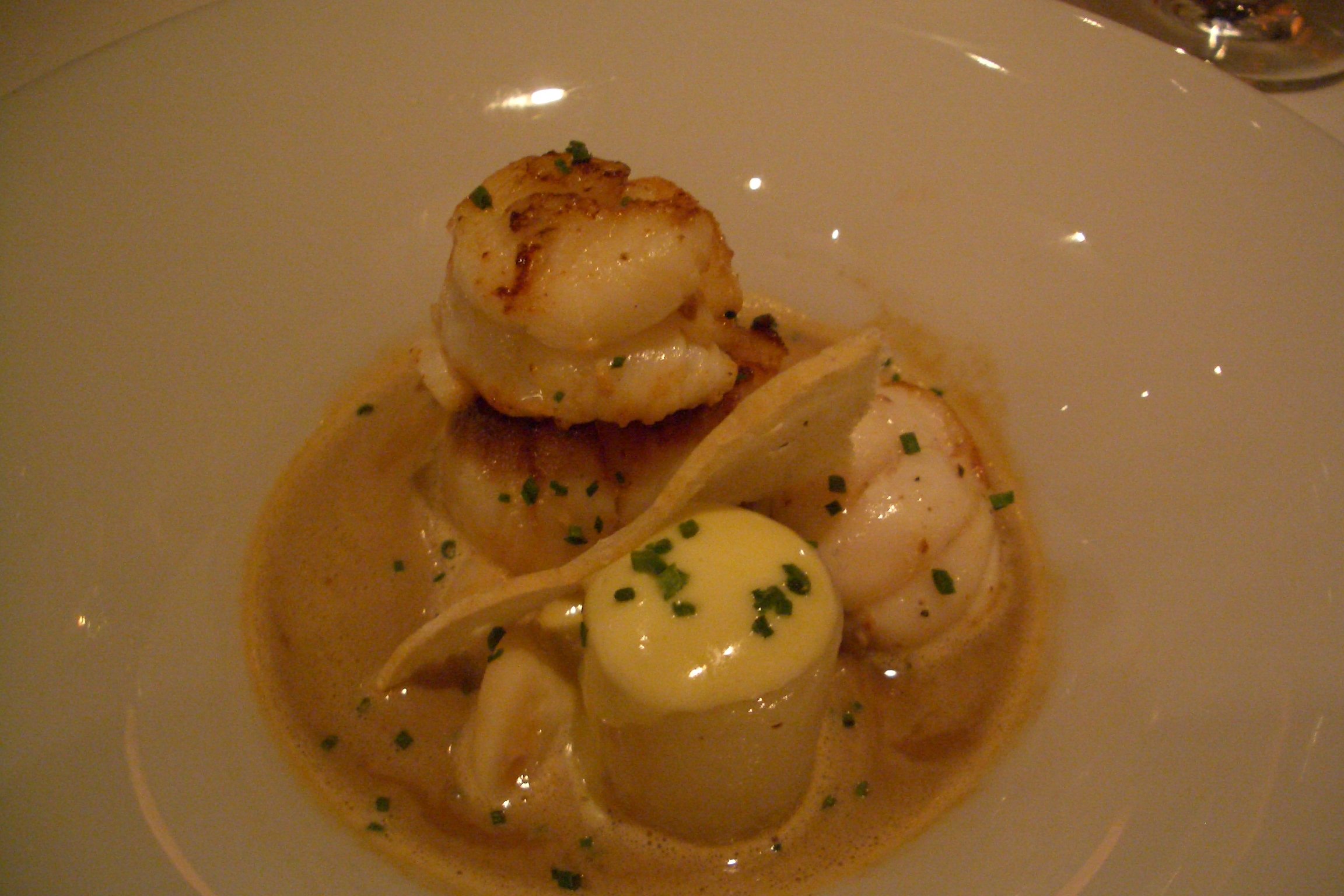 Third course: Roasted
scallops and monkfish "suquet":
A large scallop, seared to caramelization on the outside but barely
cooked on the inside, a medallion of monkfish, a fat languostine tail, some
little mollusc pieces that seemed to be diagonal cross-sections from a squid or
octopus tentacle, and a solid cylindrical plug of potato, all set in a creamy
seafood broth. The potato was topped
with a creamy chive-flecked sauce, and when we cut into it, we found that the
top had been hollowed out with a tiny melon-ball cutter so as to hold more
sauce. Yum.
Third course: Roasted
scallops and monkfish "suquet":
A large scallop, seared to caramelization on the outside but barely
cooked on the inside, a medallion of monkfish, a fat languostine tail, some
little mollusc pieces that seemed to be diagonal cross-sections from a squid or
octopus tentacle, and a solid cylindrical plug of potato, all set in a creamy
seafood broth. The potato was topped
with a creamy chive-flecked sauce, and when we cut into it, we found that the
top had been hollowed out with a tiny melon-ball cutter so as to hold more
sauce. Yum.
Fourth course: Four
slices of rare roasted duck breast fanned over a silken "mousseline"
of potato, a piped stripe of coarse pistachio purée, and poached slices of
peach garnished with yet more sprouts. Sprouts
are a major theme of the restaurant. The
kitchen must employ a full-time sprout wrangler just to keep them all straight. In two meals, we had things garnished with
sprouts of basil, arugula, chervil, celery, beet (or maybe chard), chive,
spearmint, and peppermint that I recognized and a few more that I
didn't—tarragon?, marjoram? The potatoes
were outstanding and the duck delicious, but it would have been slightly more
tender if cooked just a tad longer.
Fifth course: Another
sheep's-milk cheese, this one Spanish—no match for that amazing Berkswell, but excellent nonetheless. The waiter said it was "issybaw,"
but I haven't been able yet to track down the real spelling of that name. It was sided with more of that delicious quince
paste, a surprisingly spicy green tapenade, and more of the red-wine reduction,
which I really, really like—an excellent foil for cheese.
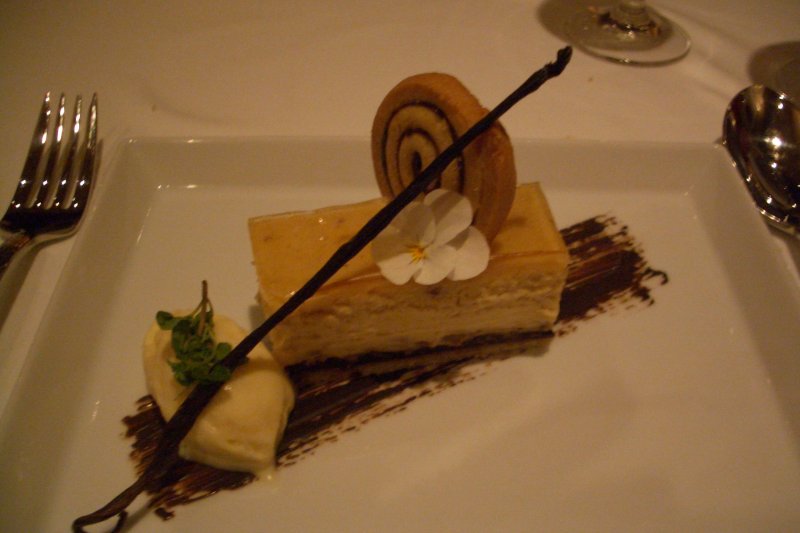 Sixth course: Fig-crusted
hazelnut cheesecake with butterscotch ice cream and a spiral patterned fig
cookie, all laid over another of those bold black brush-strokes (this one
chocolate) and garnished with peppermint sprouts, part of a vanilla bean, and a
pansy blossom.
Sixth course: Fig-crusted
hazelnut cheesecake with butterscotch ice cream and a spiral patterned fig
cookie, all laid over another of those bold black brush-strokes (this one
chocolate) and garnished with peppermint sprouts, part of a vanilla bean, and a
pansy blossom.
David's comment, partway through the meal, was "If I
were scouting chefs, I'd have this guy on a plane to New York tomorrow
morning." Alas, I had to agree with
him. We spent a good deal of the time
between courses comparing Vallès's dishes with others we've eaten, mainly in highly
rated restaurants in France, and weighing the results. The waits between courses could be long, but
were no worse than we've encountered in comparable places elsewhere (and in
establishments that have had a lot longer than three weeks to work out the
rhythm). We concluded that, in France,
Michelin would probably give him two stars—the only time that's ever happened in a the U.S. or in any restaurant to which Michelin hadn't already given two stars.
(Nobody in Tallahassee would rate even one.)

 We were slowed at the edge of town by a flagman in a hard
hat and yellow vest holding a "caution" sign, before we noticed that
he was, in fact, a scarecrow, as was the similarly clad guy on a ladder,
stringing fairy lights in the live oak behind him. We had happened on the first weekend of the
(presumably annual) three-weekend St. Marys Scarecrow Extravaganza (leading up
to Halloween), and the town was full of 'em, standing in yards, by the
roadside, on bus-stop benches, in front of stores. We cruised slowly for about six blocks,
admiring the scarecrows and the crowd of kids on the school lawn making more,
until we came to the St. Marys River (actually the junction of river's estuary
and the the inland waterway between the barrier islands and the mainland). There we turned right and cruised another
four blocks, past a lovely river-side park and an assortment of
promising-looking restaurants. That
seemed to be it—bustling downtown Historic St. Marys. It turned out to be home to, among other
things, the headquarters of the Cumberland Island National Seashore, several
antique and gift shops, a submarine museum, and a stand renting glorified golf
carts, just like on Key West. We chose
the Riverside Café for lunch. It turned
out to be (judging by the menu and our server's accent) owned and run by Greeks
but with at least one Asian working in the kitchen. I had an excellent fried grouper sandwich
with coleslaw, tartare sauce, lettuce, tomato, raw onion, and fries, and David
had stirfried shrimp and vegetables in a tasty ginger-sesame-soy sauce served
over pita with a Greek salad on the side.
The town clearly merits a day-long visit (if only to find out what that enormous brick building was about; part of the submarine base?), but our tee time was coming
up, so we set out to find our way back to the golf course—not obviously easy,
since the many signs had led us by a complex and winding route over a number of
back roads, all of which seemed to be "rte. 40" whichever way you
turned. Fortunately, a sign just at the
edge of town pointed the way to the interstate (via rte. 40, of course) and
thereby put us back on the route we knew.
We were slowed at the edge of town by a flagman in a hard
hat and yellow vest holding a "caution" sign, before we noticed that
he was, in fact, a scarecrow, as was the similarly clad guy on a ladder,
stringing fairy lights in the live oak behind him. We had happened on the first weekend of the
(presumably annual) three-weekend St. Marys Scarecrow Extravaganza (leading up
to Halloween), and the town was full of 'em, standing in yards, by the
roadside, on bus-stop benches, in front of stores. We cruised slowly for about six blocks,
admiring the scarecrows and the crowd of kids on the school lawn making more,
until we came to the St. Marys River (actually the junction of river's estuary
and the the inland waterway between the barrier islands and the mainland). There we turned right and cruised another
four blocks, past a lovely river-side park and an assortment of
promising-looking restaurants. That
seemed to be it—bustling downtown Historic St. Marys. It turned out to be home to, among other
things, the headquarters of the Cumberland Island National Seashore, several
antique and gift shops, a submarine museum, and a stand renting glorified golf
carts, just like on Key West. We chose
the Riverside Café for lunch. It turned
out to be (judging by the menu and our server's accent) owned and run by Greeks
but with at least one Asian working in the kitchen. I had an excellent fried grouper sandwich
with coleslaw, tartare sauce, lettuce, tomato, raw onion, and fries, and David
had stirfried shrimp and vegetables in a tasty ginger-sesame-soy sauce served
over pita with a Greek salad on the side.
The town clearly merits a day-long visit (if only to find out what that enormous brick building was about; part of the submarine base?), but our tee time was coming
up, so we set out to find our way back to the golf course—not obviously easy,
since the many signs had led us by a complex and winding route over a number of
back roads, all of which seemed to be "rte. 40" whichever way you
turned. Fortunately, a sign just at the
edge of town pointed the way to the interstate (via rte. 40, of course) and
thereby put us back on the route we knew.
 Amuse-bouche:
Amuse-bouche: Third course:
Third course: Sixth course:
Sixth course: